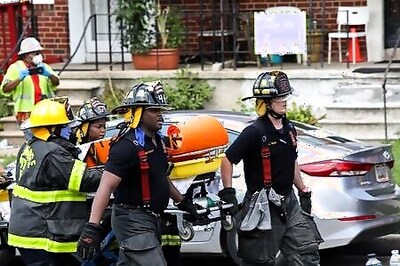
views
WASHINGTON Under pressure from the D.C. Council, Washington’s Metropolitan Police Department on Friday released long-sought body camera and security footage from the 2018 deaths of three young Black men in 2018. The release was compelled by an emergency police reform bill that Mayor Muriel Bowser criticized as rushed.
The council has determined that this is the statute, thats the law of the land and were going to abide by it, said MPD Chief Peter Newsham.
The videos relate to the deaths of three men that have become enduring causes for local activists: Marqueese Alston, 22, who was shot by police during a foot chase on June 12, 2018; D’Quan Young, 24, who was shot by an off-duty officer in civilian clothes on May 9, 2018; and Jeffrey Price, 22, who died on May 4, 2018, after his motorbike collided with an MPD cruiser.
The Young and Alston shootings were reviewed by the U.S. attorneys office for the District of Columbia, which declined to prosecute either case. Both were classified as justified by the MPDs Use of Force Review Board. Price’s death was ruled an accident.
The Price family is suing the MPD for wrongful death. Newsham, citing the lawsuit, declined to discuss the case in detail, but he called it preventable and a tragic accident where a young man lost his life.
Bowser has found herself caught between the MPD and a reformist City Council, with a resurgent street activist movement pressuring all sides. For weeks, an activist collective including Black Lives Matter has regularly staged noisy protests outside the homes of Bowser, the council members and Newsham. Earlier this month, Bowser tried but failed to fend off council-mandated cuts to police funding in the new budget.
The council unanimously passed the emergency reform bill on June 9 after a wave of nationwide protests over police brutality. With public opinion shifting toward police reform, the new bill bans the use of chokeholds and prohibits the use of tear gas or rubber bullets to disperse crowds. It also compels the speedy release of the names and body camera footage for officers involved in a serious use of force against civilians.
Bowser criticized the process as haphazard with little public input. On Friday, she acknowledged that the council had addressed some of her objections, including clarifying that family members of the victims could block certain footage from being released.
But she said she remains concerned about the council rushing to make changes to the law without adequate public input.”
The local Black Lives Matter chapter fought back against Bowser’s claim of insufficient input, calling it a blatant lie. The chapter’s Twitter feed said Friday there have been tons of hearings over the years on the issue of releasing police body camera footage.
All three videos are available on the MPDs YouTube page. Some contain graphic footage of the injuries and aftermath. Both shooting-related videos begin with an MPD statement that the department recognizes the sanctity of human life, and that any loss of life is a tragic outcome for a family and a community.
The videos also contain detailed explanations of the departments evidence in its favor, using a freeze frame and graphics to highlight a handgun in Alstons hand just before the shooting began. Price was being pursued by police when a cruiser ran a stop sign to block his path. The released video emphasizes that he was speeding in a stolen motorbike in the opposite lane. The Young video presents the department’s stance that the off-duty officer was on his way to a cookout when Young crossed the street to confront him and brandished a handgun.
The officer who killed Young was in civilian clothes and not wearing a body camera, so the city provided footage from a security camera at a nearby public recreation center and body camera footage from the first officers to respond to the scene.
Kevin Donahue, the deputy mayor for public safety, called it our attempt to show this is what we have,” and added, We did the best we could, trying to take the spirit of the law and apply it to that.
Bowser and Donahue both described the videos as frequently inconclusive.
I think people think it will be like watching a TV show, where its all clear footage coming from different angles. In fact, what it is is a camera thats on an officers chest, that sometimes doesnt show anything, Bowser said. But at the end, somebody died, and that is hard and painful to watch, but it also shows the very difficult positions that our officers face.
___
Follow Khalil on Twitter at: https://twitter.com/ashrafkhalil
Disclaimer: This post has been auto-published from an agency feed without any modifications to the text and has not been reviewed by an editor




















Comments
0 comment